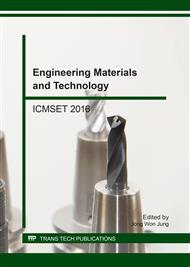p.107
p.114
p.119
p.124
p.133
p.143
p.150
p.156
p.162
Examination of the Welding Processes when Welding of Steel in Protective Gas Atmosphere of Gases with the Application of Modeling and Numerical Simulation
Abstract:
Modelling and numerical simulation of technological welding processes is the creative experimental method. Simulation replaces a real system computer model. To create the model can be applied to many experiments under predetermined conditions and analysis of the results. The results can be optimized and implemented to a real system. In a relatively short time, it is possible to solve complex processes occurring in the melting phase of the welding process, using the most advanced computer technology. Appropriately selected algorithm of model experiments can help study the course of temperature fields and formation of stresses and strains in solving the problems in the field of welding. The result of thermal and structural tasks of numerical simulation using FEM are the temperature fields, stress fields and strain generated in the process of welding and welded parts during cooling. Procedure of solving the tasks can be applied to any weld shape and any material of welded parts. The results published in the paper were obtained by solving the thermal and stress- strain tasks in the ANSYS program. Modelling and numerical simulation open possibilities for the three dimensional analysis of the phenomena studied. Based on the development of numerical methods and their application, it is possible to create computational models. Their implementation in software systems opens new possibilities for the area of numerical simulation of technological welding processes. The paper described simulation fillet and butt weld made of stainless steel 17242.
Info:
Periodical:
Pages:
133-139
Citation:
Online since:
June 2017
Authors:
Price:
Сopyright:
© 2017 Trans Tech Publications Ltd. All Rights Reserved
Share:
Citation:


